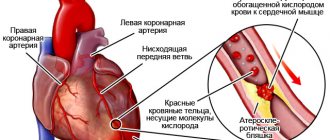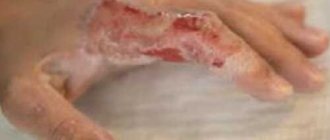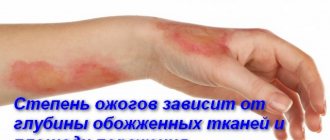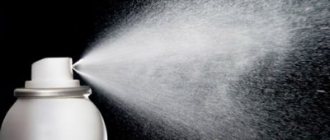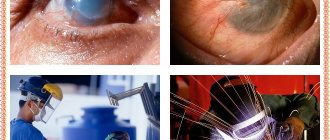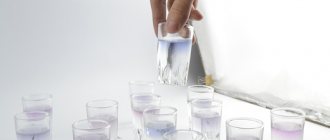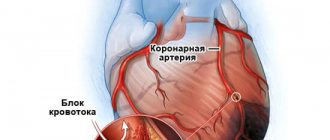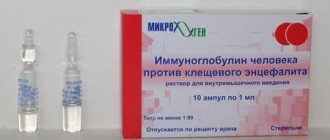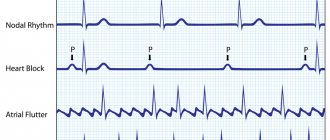Burns with boiling water are classified as thermal, i.e. resulting from exposure to high temperature liquids, contact with steam or hot objects.
There are 4 degrees of tissue damage, their severity depends on the temperature of the liquid and the duration of its contact with the skin. To minimize the consequences of your injuries, you need to learn how to properly provide first aid at home.
Additional material:
Skeletal injuries: types and characteristics
Degrees and characteristics of boiling water burns
Hot liquid can cause serious injury with subsequent complications. To prevent the consequences, it is necessary to take immediate action after boiling water gets on the body. There are several degrees of burns:
- First. Characterized by damage to the epidermis. Symptoms are swelling and redness, which disappear after a few days.
- Second. The dermis suffers, blisters, redness and swelling appear on it. If the wound does not become infected, healing takes 10-12 days.
- Third. It differs in that the depth of the lesion extends to the dermis and soft tissues. Blisters form at the site of injury, and after they are opened, scabs with purulent contents inside. Yellow subcutaneous fat is visible in the wound. After healing, scars remain.
- Fourth. Develops as a result of prolonged exposure to boiling water. The damage is severe, symptoms of a necrotic process are present on the skin, tendons and muscles suffer. The victim may experience painful shock.
Only first two degree burns can be treated at home. It is mandatory to seek qualified medical help in case of damage to the neck, genitals, face, or chest by boiling water. It is prohibited to carry out independent activities if the victim is a child!
Assessing the degree of burn
So what should you do if you scald your hand with boiling water and there is no one around? It is important to be able to navigate and analyze the extent of the injury.
Assessing the extent of damage plays an important role in further treatment.
Assessing the extent of damage plays an important role in further treatment. There are 4 known stages of burn injury:
- The first stage - only the upper skin cells are damaged. There is slight redness and swelling of the tissues. These signs go away quickly.
- The second stage is a more severe damage to the epidermis, as a result of which blisters with liquid contents develop. Adjacent tissues have a pronounced red color. Their swelling also develops. All signs of damage disappear within two weeks unless additional infection occurs.
- The third stage of injury is characterized by injury not only to the outer layers, but also to soft tissue damage. After the bladder breaks through, a scab (dry crust) forms. There is inflammation, accompanied by the release of pus. After the wound has completely healed, a scar remains on the skin.
- The fourth degree of damage is determined by severe tissue damage. The source of damage is to the ligaments, bones and deep tissues. In this condition, pain shock is present and tissue necrosis develops.
When injured by boiling water, the injury usually develops no higher than the second stage.
Damage to more than 15% of the body by boiling water is dangerous. In these cases, the help of a doctor is required. With such a burn from boiling water, first aid is of great importance, so you should not self-medicate. To independently determine this indicator, use the palm rule.
To independently determine the size of the burn, use the palm rule.
According to this technique, the entire body area is divided into multiples of nine percent zones:
- each arm makes up 9% of the entire body;
- head 9%;
- torso on each side without limbs 18%;
- each lower limb 18%;
- crotch area 1%.
To determine the size of the burn, do not touch the wound site with your palm.
First aid
Burns from boiling water of any severity must be treated immediately to eliminate serious consequences. Eliminate the source of the heat. When pouring hot liquid over your body, you need to quickly remove your clothes.
If individual pieces stick to the skin, the tissue is cut off. You can't rip it off! Threatens the formation of wounds and scarring!
Next, cool the damaged area to avoid damaging effects on tendons, muscles, and blood vessels.
To reduce the temperature under the skin you need to:
- For the first and second stages of a burn, place the affected part of the body in a basin of cold water or under running water. It should not be icy to prevent frostbite. Hold for 10 seconds until the severe pain and burning subsides.
- If boiling water gets into your mouth, throat, or tongue, you should place a piece of ice there or rinse with cold water.
After providing first aid for burns with boiling water at home, it is necessary to assess the degree of damage and area, and in case of severe injuries, call an ambulance.
To reduce pain shock, the victim can be given a local or general anesthetic.
If an arm or leg is burned, the limb should be slightly elevated to reduce swelling.
It is necessary to carry out disinfection after anesthesia. The following can help in this matter:
- antibacterial or baby soap - allowed to be applied to skin without open wounds and blisters;
- weak solution of potassium permanganate;
- hydrogen peroxide.
A sterile dressing is done on top.
What to do in case of a burn?
Our whole life is a daily encounter with dangers, all kinds of risks and problems. Pretending to be a wise minnow and hiding from the worries of the outside world in a cozy home is not a solution. Many unforeseen situations can happen to us within the walls of our own apartment: at any moment you can accidentally touch a hot iron, spill a cup of coffee on yourself, or burn your hand with steam over a boiling kettle. What to do if you are burned by boiling water? How to provide first aid to a victim injured by chemicals? In which cases you need to immediately go to the hospital, and in which burns you can get by with improvised means - we will find out in this article.
A burn occurs as a result of exposure to high temperatures and immediately turns into an open wound, accessible to any microbes. Therefore, the first and most important thing to do is to free the damaged area from clothing and immediately cool the burned area. Ice from the refrigerator, snow, very cold water or any frozen product will do. Thanks to the cold, the pain subsides for a while, as unwanted inflammatory processes in the affected tissues are stopped. After providing first aid, you must carefully examine the burn and assess the location of the skin lesion - further actions depend on the degree of the burn.
There are 4 degrees of burn, here they are:
- I degree is a mild and safe degree, in which only the upper layer of the dermis remains burned. There is noticeable redness and slight swelling on the skin;
- II degree - in addition to swelling and redness, blisters with cloudy contents appear on the affected area, and severe pain is observed. With proper treatment and emergency care, no traces of burns or scars remain;
- III degree - in this case, not only the surface of the skin remains damaged, but also deeper tissues; the burn can affect the muscles and damage them. Blisters with a cloudy liquid inside form on the burned area. Treating a third degree burn is difficult because there is a high risk of infection. Under no circumstances should treatment be carried out at home.
- IV degree is the most serious and dangerous degree of burn. High temperatures at this stage can damage the bone; skin and muscles may be absent. The most dangerous and difficult areas are the neck, face, inner arms and thighs. Patients tolerate burn injuries to their feet, back and arms (up to the elbow) more easily.
- lubricate the burn area with vegetable oil, alcohol-containing preparations, iodine, brilliant green;
- sprinkle with starch;
- apply burn ointment and other medical products to the hot surface of the skin;
- apply fermented milk products to the damaged area;
- pierce or cut through the formed blisters on the skin;
- independently clean the wound from dirt or remnants of clothing;
- wash the burn with water with the addition of soda or citric acid;
- apply a plaster to the burn.
In case of a first degree burn, treatment can be easily done at home. As soon as the first emergency aid has been provided, the cooled surface of the skin should be lubricated with a medicine that will prevent the burn from spreading into the deep layers of the skin and will relieve swelling and pain. These are drugs such as:
- Panthenol - well restores burned mucous membranes and skin, has regenerative and metabolic effects on damaged tissues. The ointment perfectly relieves burning sensation and relieves pain.
- Sulfargin - this ointment with silver ions quickly copes with wounds of a wide variety of nature.
- Levomikol - first, lubricate a gauze bandage with the ointment, and then apply it to the burn site. This bandage needs to be changed every 20 hours - the swelling will gradually subside and the pus will be eliminated.
- Olazol is a spray containing an antiseptic and anesthesin. Thanks to this composition, the drug heals burns faster.
In addition to medications, homemade compresses are also suitable for treating minor first-degree burns:
- 100 grams of finely grated potatoes should be mixed with a teaspoon of honey. Make a compress on a bandage or gauze and leave on the burn site for 2-3 hours;
- finely chop the cabbage and mix it with raw egg white, and then brush the resulting mixture onto the burn;
- instead of lotions, you can leave cooled black and green tea on the damaged area;
- cut off a juicy aloe leaf, cut it lengthwise and apply to the burned area for a few minutes;
- freshly picked plantain leaves should be washed with boiling water, cooled and applied to the affected area of the skin;
- Place finely grated carrots on gauze or bandage and apply to the burn. The compress should be changed every 2-3 hours.
This stage is already considered a fairly serious injury, so assistance is provided first at a trauma center, and then at home. The doctor carefully treats the wound, performing the following algorithm:
- anesthesia of the affected area;
- treating healthy skin next to the burn with an antiseptic;
- removing dead skin, dirt and clothing;
- carefully removing the contents of burn blisters with a sterilized instrument. The membrane of the bladder remains intact to protect the wound from bacteria and infections;
- applying a bandage with a special bactericidal ointment to the wound.
The first rule for third and fourth degree burns is no self-medication! Severe burns must be treated in a hospital. There, the doctor first carries out anti-shock therapy, surgical treatment (if it is necessary to remove dead tissue and perform skin grafting), and then hospital treatment.
What to do for burns from boiling water
- Get rid of clothing that is at the burn site as soon as possible.
- Inspect the affected area and determine the extent of damage.
- For a first or second degree burn, apply ice or make a cold compress, change the compress after a few minutes.
- If the burn is severe, go to the hospital immediately.
What to do for steam burns
- Remove clothing blocking access to the affected area of skin.
- Cool the burned surface.
- If the burn is on your hand, it should be kept elevated.
- If damage is more than 5%, go to the emergency room.
What to do for oil burns
- Cool the damaged area under running cold water.
- Apply a sterile, damp bandage to the burn site.
- If the burn is more than 1% (the palm makes up 1% of the whole body), call a doctor.
What to do for chemical burns
- Call an ambulance.
- Remove clothing from the affected area.
- Cool the burn area under running ice water.
- If the burn is caused by sulfuric acid, it must first be removed from the surface of the skin with a dry cloth.
- And if the burn is caused by quicklime, cold water will have the opposite effect! In this case, you need to remove the reagent from the affected area with a dry cloth, and then lubricate the burn with oil or greasy ointment.
Effective Home Remedies for Treatment
A properly selected medicinal drug will relieve swelling, burning, eliminate severe pain, and prevent the development of serious consequences.
For treatment it is allowed to use:
- Sulfargin is a modern effective medicine containing silver ions. The medicine helps relieve pain and quickly cure damage.
- Olazol is a burn spray with analgesic and antiseptic substances in its composition, which allows you to eliminate the negative consequences of exposure to hot liquid.
- Levomekol is an antibacterial ointment that has been proven over the years. Liniment must be applied to a bandage or gauze bandage and applied to the burn. Change the compress every 20 hours. Remove carefully, without sudden movements. Heals, reduces the risk of scarring, prevents suppuration and draws out already formed pus.
- Polimedel - the drug is produced in the form of a polymer film, which accelerates restoration processes in tissues, has a therapeutic effect, and activates regeneration.
- Argovasna Nut is a medical gel, the action of which is aimed at stimulating metabolism in the skin and accelerating recovery processes. The components in the medicine prevent the growth of scar tissue, reduce allergic reactions, and stimulate metabolic processes in the deep layers of the dermis.
- Panthenol is a recognized remedy in the treatment of burns. Foam and cream help quickly relieve the main symptom of injury – pain.
- Ricinol – has an anesthetic, anti-inflammatory, antiseptic effect. Restores the membrane of damaged cells without forming a film on the surface.
- Solcoseryl - the medicine is produced in the form of a gel. Provides tissue regeneration, dries, prevents getting wet and inflamed, and activates restoration processes.
Home care using the listed medications is allowed if the damage is stage 1-2. A serious thermal burn cannot be treated on your own! Only a doctor can take the right measures and reduce dangerous risks.
During the treatment of burns it is prohibited:
- cut off or puncture water blisters yourself, otherwise you can introduce an infection into the wound, which will subsequently lead to serious complications;
- lubricate damaged skin with any oil;
- resort to the use of traditional methods of treatment in the presence of open wounds, because products are not always sterile, and this contributes to infection;
- cauterize an existing burn with alcohol, iodine or brilliant green, because after this the specialist will not be able to assess the extent of the damage and prescribe the correct treatment;
- try to independently tear off clothing stuck to an existing burn - these actions contribute to the opening of the wound and its subsequent infection.
Treatment of 3rd and 4th degree burns takes place only in a hospital, since these are very serious injuries to the skin, tissues and muscles, and independent treatment of such injuries can only harm the general condition of the patient. Severe burns are accompanied by unbearable pain. The victim is given anti-shock therapy, and specialists prescribe injections with painkillers. It is important to calm the person, prevent panic and begin qualified treatment.
Surgical treatment is aimed at correcting the defect, after which plastic surgery is necessary. The main task in treating burns with surgical intervention is the complete removal of the toxic substance, the prevention of possible suppuration and the restoration of all processes in the area of the wound.
Traditional methods
You can effectively treat burns from boiling water at home using healthy plants and products. The folk method is allowed, but with small affected areas and shallow depth.
- Pour boiling water over plantain leaves and cool. Apply several times a day until the wound heals.
- Apply sea buckthorn oil to the burn and wait for absorption. Treatment is carried out three times a day. An important condition is that the oil is of high quality.
- Mix potato starch with water to form a thick paste. Treat the affected area every 2-3 hours and leave for 5-10 minutes. Remove the remains with cool water and apply an antiseptic on top.
- Immediately after contact with boiling water, apply salt or soda to the burn (you can use sea salt) and cover with a bandage. The swollen cover, blister, and redness will quickly disappear. In the future, the wound will heal faster.
- Heat badger fat in a water bath, lubricate a bandage with it, and apply it to the injury. Keep the bandage on for 3-4 hours, then remove and wait 3-4 hours before the next procedure.
- Oak bark 40 gr. steam with boiling water. Keep the hot broth on low heat for 10 minutes. The tincture is filtered, applied to gauze and applied to the burn.
You can use the folk recipe 3-5 days after receiving a burn with the permission of a doctor and only for injuries of 1-2 degrees. In difficult cases, the bubble risks bursting, the skin peels off and an ugly scar may remain in its place.
Folk remedies
Pumpkin pulp will help speed up the healing process.
Homemade products have the same effect as store-bought drugs. The following ingredients are suitable for treating a burn:
- pumpkin pulp;
- raw potatoes;
- aloe;
- raw chicken yolk.
Before use, all products are ground into a paste and the juice is squeezed out. If you don’t have time, you can use the pulp. Gauze is moistened with juice and applied to the wound. You can keep this compress for about 30 minutes. After this, a dressing is done.
In what cases is treatment at home contraindicated?
Before treating a burn from boiling water at home, it is necessary to assess the percentage of affected area and the extent. You cannot take steps on your own if:
- the affected area exceeds the size of the palm;
- received a deep, severe burn of 3-4 degrees with the formation of blisters, damage to surrounding soft tissues, and a necrotic process;
- if opening the wound is accompanied by symptoms of infection after 1 or 2 days.
It is important to see a doctor in time! If the burn is mild, but the symptoms worsen, you should consult a traumatologist!
We recommend reading:
Methods for treating oil burns
First aid
The outcome of treatment largely depends on correctly provided first aid. With the first degree, it is important to immediately do the following:
- The damaged area of skin must be freed from clothing.
- To prevent the appearance of blisters and speed up further recovery, you should place the burn area under cold running water or immerse it in a container of cool water for about 10-20 minutes. But keep in mind that if you cool for a long time, you can get frostbite. If the pain still does not subside, then after a while you can repeat the procedure.
- Dry the burned area of skin and apply some burn remedy to it. Apply a sterile bandage on top (no need to bandage!).
In the second degree, you should cool the burn site, apply a sterile bandage, and consult a doctor.
Attention! If you can determine that the burn is not the first or second degree, then simply apply a sterile bandage to the affected area of skin and call a doctor.
There is no need to use any folk remedies or medicines; qualified assistance is required. Drink more water to avoid dehydration. Remember that a burn is a fairly serious injury!
So, how to treat a skin burn at home?
Treatment of the burn surface with medicated bandages is called closed treatment. This is the method that will be useful for independent actions.
For a 1st degree burn, a medicated bandage is used. The best ointment for burns is Bepanten. It is enough to apply it once and apply a bandage for 4-5 days. There is no need to change the bandage during this time; the skin will have time to heal.
For a 2nd degree burn, treatment is carried out first by a doctor and then independently. The doctor will clean the burn surface and tell you how to treat the affected skin. Toilet of the burn surface without hospitalization is carried out when a small area is affected and without signs of shock. The procedure includes the following steps:
- anesthesia
- treating the skin around the burn with an antiseptic
- removal of exfoliated epithelium, dirt, clothing
- trimming and emptying large blisters; the lid of the bubble is not removed, since it serves as a kind of protection for the wound underneath
- applying an ointment bandage with a bactericidal ointment (levosulfamethakaine, streptomycin and others).
At home, the bandage is changed once every 2-3 days until the skin heals.
Treatment options for blisters
Is it possible to burst a burn blister? If bubbles have formed at the burn site, they should never be burst. Otherwise, an infection will get into the wound and treatment will be delayed. Skin with blisters is also treated with antiseptic ointments, solutions and aerosols, but without touching the blisters. For example, you can use Solcoseryl. It will dry out the resulting ulcers, relieve pain and burning and speed up the healing of wounds. After 2-3 days you can use Levomekol. It is applied in a thick layer to wounds and burns and bandaged. The dressing is changed every 20 hours . It disinfects and tightens wounds and prevents suppuration of ulcers.
Treatment of burns at home (I and II degree)
To treat I-II degree burns, both folk remedies and medications are used.
ethnoscience
Pumpkin ointment
Pumpkin ointment has analgesic, anti-inflammatory, drying, wound-healing and antiseptic properties.
To prepare a useful product, take a ripe pumpkin, peel and seed it, and grind it using a blender, meat grinder or grater. We put pumpkin puree on a piece of bandage, apply it to the burn, and fix it with a plaster. After 2 hours, remove the bandage and apply a new one. We do this 2-3 times a day.
pumpkin juice
When a burn occurs, the question often arises: “How to relieve pain?” “Very simple,” answer admirers of traditional medicine. You just need to make pumpkin juice.
Take a ripe pumpkin, peel it and remove seeds, squeeze out the juice using a grater, meat grinder, blender or juicer. Cut off a piece of bandage, dip it in juice, and lubricate the wound. We repeat the procedure 3 times a day.
Cabbage-egg ointment
Cabbage and egg ointment is known for its restorative, nourishing, anti-inflammatory, analgesic, and antimicrobial properties.
To prepare a miraculous balm, we arm ourselves with:
- cabbage leaf – 1 pc.;
- egg white – ½ pc.
Using a blender or grater, turn the cabbage leaf into puree. In a separate container, using a mixer, beat the egg whites until thick foam. Combine the ingredients and mix well. Apply the mixture to a piece of bandage, apply it to the skin, and fix it with a bandage. After 1–2 hours, remove the bandage and apply a new one. We repeat the procedure 3 times a day.
Cocktail made from soda and curdled milk
Soda and yogurt are a duet that relieves swelling, redness, itching and pain.
To prepare a cocktail, we stock up on:
- baking soda - 1 tbsp. l.;
- homemade curdled milk - 2 tbsp.
Pour yogurt into a container, add soda and whisk the mixture thoroughly. Take a piece of bandage, dip it in a cocktail, apply it to the skin, and secure it with a band-aid. Remove the bandage after 12 hours. We repeat the procedure one more time, after which we notice that there is no trace of the burn left on the skin.
Oak Elixir
The bark has anti-inflammatory, soothing, protective, wound-healing, antiseptic, nourishing, drying and analgesic properties.
To prepare oak decoction we arm ourselves with:
- crushed oak bark - 3 tbsp. l.;
- water – 1 l.
Place the bark in a saucepan, add water and mix the ingredients. Place the container on the stove, cover the container with a lid and cook the potion for 10 minutes. Remove the pan from the stove, wrap it in a towel and wait another 30 minutes. And then filter the broth through cheesecloth. We rinse the damaged skin with the potion and make lotions.
What else can I use to anoint the wound? You can also use:
- carrots (chopped on a grater);
- applesauce;
- lingonberry pulp;
- rowan juice;
- homemade cottage cheese;
- potato starch;
- raw potatoes (chopped on a grater);
- brine;
- chicken, goose and quail eggs;
- green and black tea;
- aloe juice;
- sea buckthorn oil;
- St. John's wort oil;
- tincture of calendula, elm, aspen;
- gruel from burdock leaves;
- plantain leaves;
- fresh blueberries;
- honey.
Remember, you need to be treated wisely, having first studied the properties of a particular product. In addition, use folk remedies only for closed wounds.
Medications
If for some reason you do not want to use traditional medicine, use pharmaceutical substances. Doctors advise purchasing the following medications:
- "Panthenol", known for its analgesic and restorative effect;
- "Ricinol", which has antiseptic, regenerating, analgesic, cleansing, anti-inflammatory properties;
- “Silcoseryl”, which has a drying, antiseptic, regenerating, nourishing, wound-healing effect;
- "Olazol", demonstrating analgesic, antimicrobial, anti-inflammatory, antiseptic, restorative properties;
- gel wipes, known for their cooling, analgesic and antimicrobial properties;
- "Furaplast", which has an antimicrobial and healing effect;
- "Bepanten", which has cooling, antiseptic and analgesic properties;
- “Rescuer”, demonstrating antibacterial, nutritional and regenerating effects;
- "Actovegin", known for its analgesic and stimulating properties;
- "Chlorhexidine", which has excellent antiseptic and antimicrobial properties.
Of course, there are other drugs. Therefore, each person can choose the remedy that is most acceptable to him.
Timely and competent first aid, plus proper treatment of a burn, is the key to a quick recovery. That's all. I hope it was informative. There will be even more useful information further. And in order not to miss it, I advise you to subscribe to blog updates. See you, come again!
Wisdom Quote: He who does nothing never makes mistakes (Theodore Roosevelt).
Traditional therapy
These injuries take a very long time to heal, bringing significant discomfort to the person in the form of pain and severe burning. In some cases, when the burns are severe, they can cause the victim to go into shock, which can be fatal. For mild injuries, the use of anti-burn ointments can help; for severe injuries, only complex therapy in a specialized clinic.
Drug treatment
For a burn with boiling water, treatment is most often carried out using local remedies. An ointment that cures burns with boiling water relieves pain and swelling. It can be selected from the following list:
- Panthenol.
- Depantol.
- Bepanten.
- Pantoderm.
- Dexpanthenol.
- Levomikol.
These remedies work well for minor burns from boiling water, which makes them extremely popular, but they are powerless for deep injuries from hot water. If the victim was hospitalized in a hospital, then doctors will carry out a whole range of measures to improve the patient’s condition; ointment alone will not do.
Treatment of 2nd and 3rd degree burns with boiling water is usually carried out in a hospital, for which the patient is first given an injection of an anesthetic drug, and then manipulations begin. Bandages for such wounds can be closed, when the wound is completely closed, or open, when the burn is not covered with cloth, but the skin is treated and the area is left open. Some cases of such injuries require surgery to graft damaged tissue or remove scabs. If the burn is very extensive and deep, doctors often remove the limbs of such patients.
You can quickly cure a burn from boiling water of moderate severity only by using the following groups of medications:
Local antiseptic medications (Dermazin, Silvederm).
- Wound coverings (Activtex, Biodespol).
- Drugs that improve the body's metabolic processes and have a regenerating and healing effect (Panthenol, Solcoseryl).
- Broad-spectrum antibacterial drugs (Cefixime, Amoxicillin).
When transporting such a patient, the ambulance team decides how best to provide pain relief. For severe burn injuries, intravenous administration of strong painkillers, including narcotic drugs (Morphine, Codeine), is used.
Consequences
Only specialists know how to provide assistance for a 3-4 degree burn with boiling water, when a large area of the body is affected. An important component of this stage of treatment is anti-shock therapy. Before quickly administering anesthesia to the patient, the doctor assesses the situation; if the case is severe, then the patient develops a burn disease that requires immediate help.
Burn disease is a shock received by a person under the influence of high temperatures on his body. This complication occurs in rare cases when extensive and deep tissue damage has occurred.
The duration of burn shock is usually about 3 days. During this pathological process, certain changes occur in the victim’s body:
- acid-base and water-electrolyte balance changes;
- kidney function is impaired.
Acute burn toxemia is a severe process and lasts about 14 days. The consequence of this condition can be acute renal failure. Burn disease can have the following stages:
- Septicotoxemia. Represents the stage in which the wounded surface of the skin is usually cleansed. Often this pathology is accompanied by a disorder of the functioning of all internal organs, as well as ulceration of the intestinal tract or pneumonia, which is caused by improper blood circulation caused by blockage of small arteries and vessels.
- Convalescence. This degree of burn disease is considered final; it can last until the person recovers, when the body tissues are completely healed.
Manifestations of a burn
Unfortunately, anyone can be scalded by boiling water. Compared to injuries from boiling brines and syrups, hot water is not as dangerous.
The degree and depth of damage depend on a number of factors:
- liquid temperature;
- area of affected skin surface;
- volume and time of exposure to hot water.
A hand burn from boiling water is recorded in practice more often; the chest, abdomen, thighs, and legs are less likely to be affected. Symptoms in children are more pronounced.
The clinical manifestations of a first degree burn are as follows:
- severe sharp pain;
- rapid reddening of the skin - acute sensitivity occurs;
- swelling at the site of injury.
Deeper tissue damage by boiling water of the second degree is expressed by the appearance of blisters with watery contents. There is a risk of wound infection after opening the blisters.
A thermal burn with boiling water of the third degree manifests itself in blood blisters, severe pain, leading to a state of shock for the victim. The patient needs urgent hospitalization.
A fourth degree burn with damage to bone tissue is not typical for scalded patients; it is extremely rare - in cases of prolonged exposure to boiling water, necrosis of muscle and bone tissue. The negative consequences of grade 2-3 injuries can also be very severe, affecting the quality of life, physical and psychological health of the victim.
The most dangerous are burns to the face, neck, inner thighs, and arms. Depending on the extent and location of the lesion, the issue of hospitalization of the patient is decided.
